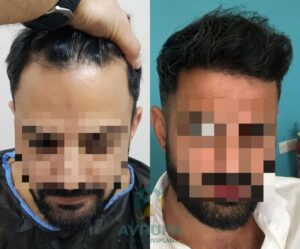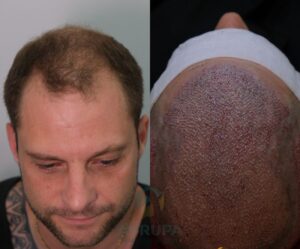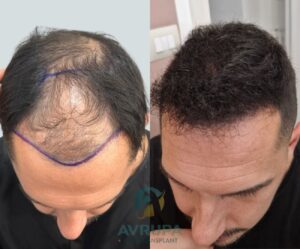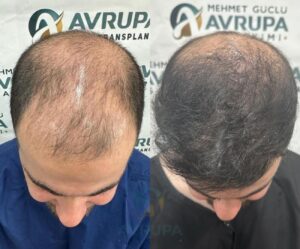The Norwood Hair Scale: Stages, Photos & Treatment Paths
October 5, 2025 by
avrupahairtransplant
Hair loss is one of the most common concerns among men worldwide, and understanding its progression is the first step in managing it effectively. The Norwood Hair Scale, also known as the Hamilton-Norwood Scale, is the most widely used classification system to describe the stages of male pattern baldness (androgenetic alopecia).
This scale provides doctors, patients, and researchers with a standard framework to track hair loss, compare cases, and determine the right treatment path. Below, we’ll cover each Norwood scale with real pictures in detail, explain what it looks like, show photo-based patterns, and discuss recommended treatments at every stage.
What Is the Norwood Hair Scale?
The Norwood hair scale is a clinical tool that categorizes male pattern baldness into seven stages based on severity and pattern of recession. It was first described by Dr. James Hamilton in the 1950s and refined by Dr. O’Tar Norwood in the 1970s.
The purpose of the Norwood scale is to help surgeons plan hair restoration procedures, guide dermatologists in prescribing medications and allow patients to understand where they stand in the progression of baldness.
Norwood Hair Scale Stages Explained (With Photos)
Each stage represents a progressive level of hairline recession and crown thinning. While photos are typically shown in medical charts, here we’ll explain what each stage looks like so you can clearly identify it and compare it with your situation.
Norwood Stage 1
This is the “baseline” stage where there is little to no visible hair loss. The hairline remains juvenile and sits low on the forehead, forming a natural, rounded frame. Both temples are completely intact with no sign of recession, and the crown area (vertex) is full.
-
How It Looks: Someone in Stage 1 will appear to have a strong, dense hairline with even coverage across the scalp. There may be minor shedding or seasonal hair loss, but it does not result in permanent thinning.
-
Comparison: If you still see a straight or slightly curved hairline with no temple dips, you are most likely in Stage 1.
-
Treatment Paths:
-
No intervention required.
-
Preventive care: balanced nutrition, avoiding scalp damage.
-
Taking baseline photographs can help monitor changes over time.
-
Norwood Stage 2
The first subtle signs of change appear. The hairline starts to move back slightly at the temples, often forming an “M” shape. This is sometimes called a mature hairline rather than balding, as it can be a normal adjustment with age.

-
How It Looks: The temples look slightly higher than before, but the overall density across the scalp remains thick. The crown is unaffected at this point. To the untrained eye, Stage 2 is barely noticeable and often dismissed as a natural part of growing older.
-
Comparison: If your forehead looks a little larger or your temples aren’t as rounded as before but you still have strong coverage, you are likely at Stage 2.
-
Treatment Paths:
-
Early use of FDA-approved medications (finasteride, minoxidil) can slow progression.
-
PRP (Platelet-Rich Plasma) therapy for preventive strengthening.
-
Lifestyle adjustments: scalp care, nutrition, stress management.
- In some cases, a minor hair transplant can be done to make the hairline more pronounced.
-
Norwood Stage 3
This is the first stage officially classified as baldness. The temple recession deepens, creating a more pronounced M, U, or V shape. The hairline pulls back more significantly and can give the forehead a broader look.

- How It Looks: People at this stage often notice that hairstyles don’t look the same anymore, especially shorter cuts that expose the temple areas. Hair density in the front starts to thin, and photos taken from different angles reveal the recession more clearly.
-
Comparison: If the temples form a visible M or U shape with a noticeable loss of density in the front third of the scalp, you may be in Stage 3.
-
Treatment Paths:
-
Prescription treatments (finasteride, dutasteride) to halt progression.
-
Minoxidil to maintain density in surrounding areas.
-
PRP or low-level laser therapy as supportive options.
-
Hair transplant is viable if hair loss is stable.
-
At Norwood Stage 3?
This is the sweet spot where you can actually start considering a hair transplant to restore the hairline and temples.
Norwood Stage 3 Vertex
Unlike standard Stage 3, this stage involves thinning at the crown (vertex) instead of—or in addition to—frontal recession. A circular bald spot begins to appear at the top of the head.
-
How It Looks: From the front, the hairline may still look decent, but from above or behind, a noticeable thin patch or bald circle can be seen. Lighting often makes the crown loss more obvious.
-
Comparison: If friends or family point out a bald spot on the back of your head or you notice scalp visibility under bright light, this may be Stage 3 Vertex.
-
Treatment Paths:
-
Same as Stage 3 treatments (medications, PRP, laser therapy).
-
Hair transplant may require careful planning to balance crown and frontal coverage.
-
Norwood Stage 4
Hair loss is now clearly visible both in the front and crown. The temple recession deepens further, and the bald spot on the crown expands. A thin strip of hair (the “bridge”) still separates the two areas of loss.

-
How It Looks: From the front, the forehead is much larger, and temples have receded deeply. From the top, the bald spot at the crown is obvious and continues to spread outward. Hairstyles can no longer conceal thinning easily.
-
Comparison: If you notice significant loss at both temples and a distinct bald spot at the crown with only a narrow band of hair between them, you are in Stage 4.
-
Treatment Paths:
-
Combination therapy (finasteride + minoxidil + PRP).
-
Hair transplant with 2,500–3,000 grafts may be needed for natural restoration.
-
SMP (scalp micropigmentation) as a non-surgical camouflage option.
-
Norwood Stage 5
The bald areas at the temples and crown continue to expand and nearly meet. The strip of hair separating them becomes much thinner and weaker.

- How It Looks: From almost any angle, baldness is now very apparent. The front hairline is significantly receded, and the crown patch has widened. Styling options are limited, and attempts to cover the bald areas (like combovers) no longer look natural.
-
Comparison: If the bridge of hair between the crown and hairline is faint and thinning rapidly, and bald patches dominate your scalp, this is Stage 5.
-
Treatment Paths:
-
Aggressive medical therapy to stabilize any remaining hair.
-
Larger hair transplant sessions (4,000–4,500 grafts).
-
SMP or hair systems if donor hair is limited.
-
Norwood Stage 6
At this stage, the bridge of hair that once separated the crown and frontal hairline is gone. The balding regions merge into one large bald area covering the majority of the top of the head. Only the sides and back retain hair.

-
How It Looks: The scalp looks bare from the front to the back. Only a horseshoe-shaped fringe of hair remains around the sides and back. Hairstyles cannot disguise the baldness anymore.
-
Comparison: If your baldness covers nearly the entire top of your head and only side hair remains, you are in Stage 6.
-
Treatment Paths:
-
Large transplant sessions, usually planned over multiple sessions (4,500–6,000 grafts, depending on donor area).
-
SMP to blend density and create a fuller appearance.
-
Non-surgical solutions like advanced hair systems.
-
Norwood Stage 7
This is the most advanced stage of male pattern baldness. Only a thin horseshoe-shaped ring of hair remains around the back and sides of the scalp. The top is completely bald.
-
How It Looks: The scalp is bare across the crown, vertex, and hairline with little density even in the horseshoe region. The remaining side hair is often fine and not strong enough to serve as a donor for transplant.
-
Comparison: If you have total baldness across the top and only thin hair around the sides/back of your head, you are in Stage 7.
-
Treatment Paths:
-
A single, carefully planned transplant session may be possible if donor hair is strong enough, but results are usually modest and cannot restore full density. Surgeons may focus on reconstructing just the frontal hairline or a partial coverage zone for a natural frame. In some cases, it may not be viable due to poor donor supply.
-
SMP, full hair systems, or embracing the bald look are more realistic options.
-
Medications have little effect at this stage but may preserve remaining hair.
-
Treatment Options Across All Stages
While treatment must be stage-specific, these are the most common pathways:
-
Medications:
-
Finasteride (oral DHT blocker).
-
Dutasteride (more potent DHT blocker).
-
Minoxidil (topical or oral).
-
-
Procedures:
-
PRP therapy – injections that stimulate follicle activity.
-
Low-Level Laser Therapy (LLLT) – laser caps, helmets.
-
Hair Transplants (FUE/FUT) – surgical redistribution of follicles.
-
Scalp Micropigmentation (SMP) – cosmetic tattooing for fuller look.
-
-
Lifestyle & Support:
-
Balanced diet with protein, zinc, and biotin.
-
Stress reduction (yoga, meditation, exercise).
-
Proper hair/scalp hygiene.
-
Why Does the Norwood Scale Matter?
-
For Patients: Helps understand where they stand and what treatments are realistic.
-
For Surgeons: Guides transplant planning and graft allocation.
-
For Research: Provides a universal classification system for male pattern baldness.
Ready to turn your Norwood stage into a plan?
Stabilize your hair loss and plan natural restoration with our professional team that treats thousands of international patients. Start with a free assessment! Compare techniques, graft ranges, and costs with our personalized Hair Restoration Turkey program.
Bottom Line
The Norwood Hair Scale remains the gold standard for tracking male hair loss progression. Recognizing your stage early can make all the difference in choosing effective treatments and slowing the progression of baldness.
If you’re in the early stages, medical therapies can help preserve your hair. For advanced stages, hair transplants, SMP, or modern cosmetic options can restore confidence.
Written By
avrupahairtransplant
Avrupa Hair Transplant Clinic, Istanbul’s trusted name since 2006, transforms hair restoration with cutting-edge techniques like FUE, DHI, and Sapphire, crafting natural, lasting results. With over 40,000 success stories and a collection of international awards, Avrupa blends innovation with artistry, delivering personalized care that redefines confidence for clients worldwide.